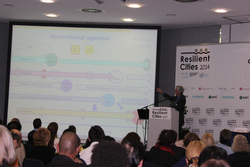As the 5th Global Forum of Urban Resilience and Adaptation concludes, we invite you to the 6th year of this Global Forum from 8-10 June 2015 in Bonn, Germany. Additionally to enhance resilience and adaptation in the Asia region with a focus on developing countries, we present you with the 1st Resilient Cities Asia Conference from 11-15 February 2015 in Bangkok, Thailand.
Find more information here: www.iclei.org/bonn2014
Read the live blog: resilientcitiesblog.iclei.org





